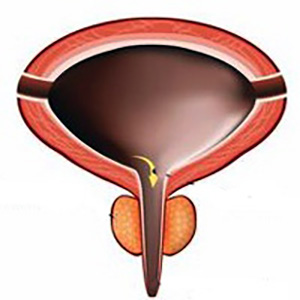The choice of therapeutic agent in female overactive bladder patients in real-world practice

Accepted: November 10, 2022
All claims expressed in this article are solely those of the authors and do not necessarily represent those of their affiliated organizations, or those of the publisher, the editors and the reviewers. Any product that may be evaluated in this article or claim that may be made by its manufacturer is not guaranteed or endorsed by the publisher.
Objective: The reasons why anticholinergic drugs or β3 adrenergic agonists are selected as treatments for overactive bladder (OAB) are unclear. The aim of this study was to investigate the background data of female OAB patients that were prescribed anticholinergic drugs or β3 adrenergic agonists in a real-world setting.
Materials and methods: Between January 2013 and December 2014, 75 patients who had been diagnosed with OAB were included in this study. Administered medications, age, the persistence on treatment rate at one-year, medical history, pretreatment total Overactive Bladder Symptom Score (OABSS), pretreatment score for each OABSS factor, body mass index (BMI), and various comorbidities were evaluated retrospectively. Since there were many types of anticholinergic drugs and few patients, we grouped the patients into those that were prescribed anticholinergic drugs (group A) and those that were prescribed β3 adrenergic agonists (group B).
Results: 75 patients (29 in group A and 46 in group B) were included in this study. There were no significant differences in age, BMI, obesity, medical history, pretreatment total OABSS, or pretreatment score for each OABSS factor. There was a significant difference in the post-voiding residual urine volume (PVR) between the groups (group A: 22 ml, group B: 9 ml; p = 0.0252). The 1-year persistence on treatment rate was 28% in both groups.
Conclusions: There were no significant differences in clinical characteristics of patients who were prescribed anticholinergics and β3 adrenergic agonists for OAB treatment, but a marginal difference of PVR value before treatment. The 1-year persistence rates of anticholinergic drugs and β3 adrenergic agonists were considered to be almost equivalent.
Abrams P, Cardozo L, Fall M Paul Abrams, et al. The standardisation of terminology of lower urinary tract function: report from the Standardisation Sub-committee of the International Continence Society Neurourol Urody. 2002; 21: 167-178.
Homma Y, Yamaguchi O, Hayashi K. Neurogenic bladder society committee. An epidemiological survey of overactive bladder symptoms in Japan. BJU Int. 2005; 96:1314–1318.
Eapen RS, Radomski SB. Review of the epidemiology of overactive bladder. Res Rep Urol. 2016; 8: 71-76.
Brown JS, McGhan WF, Chokroverty S. Comorbidities associated with overactive bladder. Am J Manag Care. 2000;6: S574-579.
Subak LL, Richter HE, Hunskaar S. Obesity and urinary incontinence: epidemiology and clinical research update. J Urol. 2009; 182: S2-7.
Yamaguchi O, Nishizawa O, Takeda M, et al. Clinical guidelines for overactive bladder. Int. J. Urol. 2009; 16: 126–142.
Khullar V, Amarenco G, Angulo J, et al. Efficacy and tolerability of mirabegron, a β (3)-adrenoceptor agonist, in patients with overactive bladder: results from a randomised European-Australian phase 3 trial. Eur Urol. 2013; 63: 283–295.
Yamaguchi O, Marui E, Kakizaki H, et al. Phase III, randomised, double-blind, placebo-controlled study of the β3-adrenoceptor agonist mirabegron, 50 mg once daily, in Japanese patients with overactive bladder. BJU Int. 2014; 113: 951-960.
Chapple CR, Nazir J, Hakimi Z, et al. Persistence and Adherence with Mirabegron versus Antimuscarinic Agents in Patients with Overactive Bladder: A Retrospective Observational Study in UK Clinical Practice. Eur Urol. 2017; 72: 389-399.
Yeowell G, Smith P, Nazir J. et al. Real-world persistence and adherence to oral antimuscarinics and mirabegron in patients with overactive bladder (OAB): a systemic literature review. BMJ open. 2018; 8: e021889.
Yamaguchi O, Ikeda Y, Ohkawa S. Phase III Study to Assess Long-Term (52-Week) Safety and Efficacy of Mirabegron, a β 3 -Adrenoceptor Agonist, in Japanese Patients with Overactive Bladder. LUTS. 2017; 9:38-45.
Stöhrer M, Madersbacher H, Richter R, et al. Efficacy and safety of propiverine in SCI-patients suffering from detrusor hyperreflexia-a double-blind, placebo-controlled clinical trial. Spinal Cord. 1999; 37: 196-200.
Nitti VW, Khullar V, van Kerrebroeck P, et al. Mirabegron for the treatment of overactive bladder: a prespecified pooled efficacy analysis and pooled safety analysis of three randomised, double-blind, placebo-controlled, phase III studies. Int J Clin Pract. 2013; 67: 619-632.
Wagg A, Compion G, Fahey A, Siddiqui E. Persistence with prescribed antimusucarinic therapy for overactive bladder: a UK experience. BUJ Int. 2012; 110: 1767-1774.
Wagg A, Franks B, Ramos B and Berner T. Persistence and adherence with the new beta-3 receptor agonist, mirabegron, versus antimuscarinics in overactive bladder: Early experience in Canada. Can Urol Asso J. 2015; 9;343-350.
Sussman D, Yehoshua A, Kowalski J, et al. Adherence and persistence of mirabegron and anticholinergic therapies in patients with overactive bladder: a real-world claims data analysis. Int J Clin Prac. 2017;71: e12824.
Kalder M, Pantazis K, Dinas K, et al. Discontinuation of Treatment Using Anticholinergic Medications in Patients With Urinary Incontinence. Obstet Gynecol. 2014; 124: 794-800.
Wada N, Watanabe M, Banjo H, et al. Long-term persistence with mirabegron in a real-world clinical setting. Int J Urol. 2018; 25: 501-506.
DeJong C, Aguilar T, Tseng CW, et.al. Pharmaceutical Industry–Sponsored Meals and Physician Prescribing Patterns for Medicare Beneficiaries JAMA Intern Med. 2016;176: 1114-1122.
Copyright (c) 2022 the Author(s)

This work is licensed under a Creative Commons Attribution-NonCommercial 4.0 International License.
PAGEPress has chosen to apply the Creative Commons Attribution NonCommercial 4.0 International License (CC BY-NC 4.0) to all manuscripts to be published.


 https://doi.org/10.4081/aiua.2022.4.451
https://doi.org/10.4081/aiua.2022.4.451



